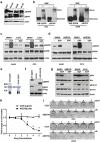Intracellular activation of EGFR by fatty acid synthase dependent palmitoylation
- PMID: 26378037
- PMCID: PMC4741504
- DOI: 10.18632/oncotarget.5252
Intracellular activation of EGFR by fatty acid synthase dependent palmitoylation
Abstract
Epidermal growth factor receptor (EGFR) is an oncogenic receptor tyrosine kinase. Canonically, the tyrosine kinase activity of EGFR is regulated by its extracellular ligands. However, ligand-independent activation of EGFR exists in certain cancer cells, and the underlying mechanism remains to be defined. In this study, using PC3 and A549 cells as a model, we have found that, in the absence of extracellular ligands, a subpopulation of EGFR is constitutively active, which is needed for maintaining cell proliferation. Furthermore, we have found that fatty acid synthase (FASN)-dependent palmitoylation of EGFR is required for EGFR dimerization and kinase activation. Inhibition of FASN or palmitoyl acyltransferases reduced the activity and down-regulated the levels of EGFR, and sensitized cancer cells to EGFR tyrosine kinase inhibitors. It is concluded that EGFR can be activated intracellularly by FASN-dependent palmitoylation. This mechanism may serve as a new target for improving EGFR-based cancer therapy.
Keywords: EGFR; cancer; fatty acid synthase; palmitoyl transferases; palmitoylation.
Conflict of interest statement
All authors declare no actual, potential, or perceived conflict of interest that would prejudice the impartiality of this article.
Figures






References
Publication types
MeSH terms
Substances
Grants and funding
LinkOut - more resources
Full Text Sources
Other Literature Sources
Research Materials
Miscellaneous

